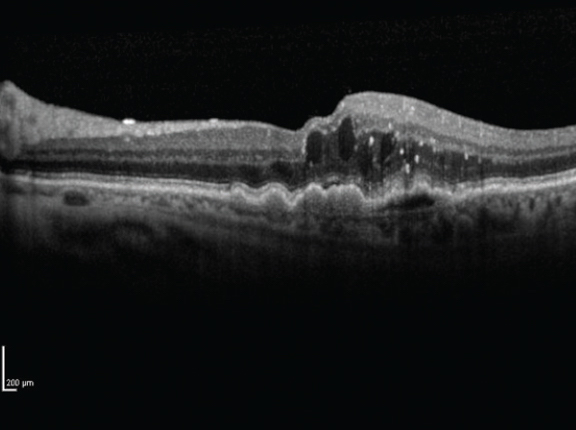 |
| Using a unique polygenic prediction model, researchers in this study identified more than 60 loci believed to predict AMD risk among a European population. Click image to enlarge. |
Current evidence suggests that a genetic component is involved in the pathogenesis of age-related macular degeneration, the leading cause of central vision loss in adults over 50. To date, more than 50 loci of AMD risk genes have been identified through genome-wide association studies (GWAS). Building on this research, a team of investigators in Europe recently conducted a large analysis on six GWAS to identify novel loci and enable the construction of a polygenic risk score (PRS).
A total of 64,885 European AMD cases and 568,740 controls across the six cohorts were included in the multi-trait meta-analysis. The researchers identified 63 AMD risk loci, as well as the two well-established loci, CFH and ARMS2. Nine of these loci had not been reported in previous GWAS, but some had been previously linked to glaucoma or other eye diseases.
Combining both the newly identified loci from this analysis, along with the previously reported loci, the researchers developed a PRS. They used a different polygenic prediction method than in previous studies called PRS-CS, which the researchers explained increased the number of SNPs, employed the most accurate weights for the prediction and ensured the proper weights were used for some of the model's key SNPs. Compared with prior models, they reported that theirs significantly improved the prediction accuracy of AMD risk.
The researchers wrote in their paper, published recently in Ophthalmology, “One general conclusion from years of investigative efforts is that much of our ability to predict AMD comes from the CFH and ARMS2 loci.” But interestingly, in this analysis, they noted that, “even within the group of people carrying a high burden of CFH and ARMS2 risk alleles, the risk of AMD can vary substantially,” ranging from close to zero in low-PRS individuals to >50% in high-PRS individuals. They pointed out that this was especially true for people over 80, whose “prevalence and cumulative incidence of AMD demonstrated large differences between high PRS and low PRS individuals.”
Because of these findings, the team suggested that looking at loci other than CFH and ARMS2 could offer important risk stratification.
While this analysis involved mainly individuals of European ancestry, the researchers noted in their study that “the PRS shows potential for predicting risk in people of East Asian, South Asian and Latino ancestry,” though they do recommend a large cross-ancestry study be performed to establish a more robust prediction model.
“In summary, our study identified nine novel AMD loci via a multi-trait GWAS and meta-analysis, and subsequently developed a new AMD PRS,” the researchers concluded.
He W, Han X, Ong JS, et al. Genome-wide meta-analysis identifies novel loci and improves disease prediction of age-related macular degeneration. Ophthalmology. August 25, 2023. [Epub ahead of print]. |

